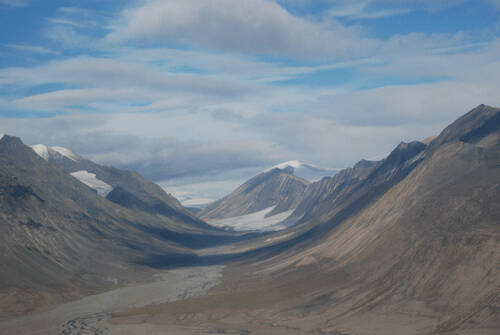By Ned Rozell
Twelve summers ago, Joel Barker was measuring gases wafting from the tundra on Ellesmere Island in Canada’s far north. One day he took a break from his duties to check out a report from a warden stationed there at Canada’s northernmost national park — in a land that has not hosted trees for thousands of years, the warden had seen some wood protruding from mud near a glacier.
Barker, then a researcher at Ohio State University and now at the University of Minnesota, took a helicopter ride to a U-shaped valley that was home to a few musk oxen and ankle-high willows. There, the warden led him to a dirty pile of roots and small gray logs.
“It was surreal,” Barker said. “I had been very skeptical.”
He and the warden gathered a few samples of the wood and then jumped on the helicopter after being on the ground less than one hour. On the ride back to his base camp, Barker felt the flush of discovery.
“I couldn’t wait to get back (to analyze the wood),” Barker said.
After a summer of fieldwork in the frigid north, Barker, who was then at the University of Alberta, packed his plastic bags containing the wood and began the long trip south. Once back at his lab, he sent samples of the mystery wood to the University of Minnesota and sent pollen grains he had gathered to a laboratory in Calgary. He was stunned to learn that the logs on Ellesmere Island were at least 2 million years old.
“It’s hard to wrap your head around that concept — that this wood was 2 million years old but wasn’t petrified,” he said.
Barker refers to the forest as “mummified.” Logs, cones and other tree remains were dried and preserved because a landslide smothered them from oxygen and moisture that would fuel soil microbes.
Barker returned to the site in summer 2010. When he spent more time at the edge of the melting glacier, he uncovered something more amazing than the wood — dry leaves, packed in layers and protected from the environment by a blanket of soil.
“If you went for a walk in late fall in Ohio, these leaves looked a lot like what you’d see on the ground,” Barker said. The difference is that a chilly arctic breeze shook these leaves to the ground at least 2 million years ago.
Barker collected samples of the delicate, flakey leaves, and his research attention shifted from analyzing tundra gases to what a mummified forest could tell scientists about the world’s distant past.
Ellesmere Island and other far-north areas were not always the barren, frozen landscapes that they are today. During a warm period from about 55 to 14 million years ago, Metasequoia (dawn redwood) trees grew in Canada’s high arctic.
Researchers have found wood from those trees preserved in frozen riverbanks and other places, and have written that forests in the high arctic were probably similar to those in the Pacific Northwest today. Pollen samples from lake-bottom muck also show that basswoods, hickories, elms and other trees grew in Alaska and other northern places millions of years ago.
Those fair-weather trees suggest a very warm period in the far north, while the mummified forest of Ellesmere Island suggests a climate in transition from comfortable to bitter cold. Scientists believe the northern climate began to cool about 11 million years ago.
“Species diversity is quite low at this site,” Barker said. “We find pine, spruce, birch and larch. This was an ecosystem on the decline, barely struggling to keep going in this environment.”
The mummy trees of northern Ellesmere Island include a trunk of a pine tree four feet long and six inches in diameter. Each of the trees was at least 75 years old when it died. The ancient forest holds samples of the last real trees in the area before it became too cold and dry to support large plants, Barker said.
“We believe this is the northernmost treeline as things were deteriorating (to a cooler state),” he said.
Barker said the big-picture significance of the mummified forest is that it may allow researchers to see how the arctic system responded to past climate change, which might be useful in predicting how the high arctic will react to today’s changes and those in the future.
• Since the late 1970s, the University of Alaska Fairbanks’ Geophysical Institute has provided this column free in cooperation with the UAF research community. Ned Rozell is a science writer for the Geophysical Institute. A version of this column ran in 2011.

